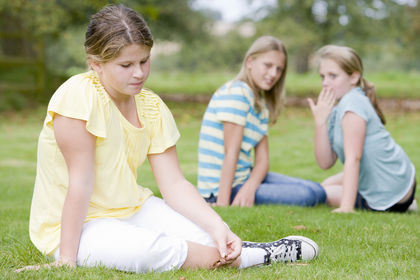Peer groups

Definition
Peer groups are an important influence throughout one's life, but they are more critical during the developmental years of childhood and adolescence. There is often controversy about the influence of a peer group versus parental influence, particularly during adolescence. Recent studies show that parents continue to have significant influence, even during adolescence, a reassuring finding for many parents. It appears that the power of the peer group becomes more important when the family relationships are not close or supportive. For example, if the parents work extra jobs and are largely unavailable, their children may turn to their peer group for emotional support. This also occurs when the conflict between parents and children during adolescence, or at any time during a child's development, becomes so great that the child feels pushed away and seeks closeness elsewhere. Most children and adolescents in this situation are not discriminating about the kind of group they join. They will often turn to a group simply because that group accepts them, even if the group is involved in illegal or negative activities. Gang involvement, for example, is a common form of organized—often antisocial—peer interaction. Gangs may be based on ethnicity, sex, and/or common activity. Most youths who join gangs come from families where drug and alcohol use, financial burdens, and broken relationships are common. The need for affiliation or closeness is often greater than the need to "do the right thing" for some adolescents who feel isolated and abandoned by members of their own family. Being part of a gang provides such individuals with acceptance and security not available at home or in other peer groups.
Membership in peer groups
Despite significant gains in diversity training, current studies continue to show that children are less likely to accept those who are different from themselves. The differences can be as obvious as physical impairments, or as subtle as differences in academic motivation. These rigid standards may create an atmosphere of exclusion for some children and adolescents that pushes them toward peer acceptance of any type.
Peer groups offer children and adults alike the opportunity to develop various social skills, such as leadership, sharing or teamwork, and empathy. Peer groups also offer the opportunity to experiment with new roles and interactions, similar to treatment groups, although they are less structured. It is for this reason that many children and adolescents drift from one group to another as they "find themselves," or work toward formation of their relatively permanent identity.
Aggression in peer groups
Although bullying and teasing have long been part of peer group interactions, these negative behaviors have increased over the last decade, resulting in school violence in many instances. As children and adolescents feel

Negative peer interactions also occur more frequently following friendships or romantic relationships that have gone sour. The level of harassment that many of these children—often young women—experience is great enough for parents to become involved. In some cases, it may be necessary to move the child to another school district. A potential remediation for these negative interactions includes more active teacher involvement when negative social interactions are observed.
Influence of peer groups
Peer groups can also have a positive influence—a fact many parents have known for years. Studies support parent's perceptions that the influence of friends can have a positive effect on academic motivation and performance. Conversely, experimentation with drugs, drinking, vandalism, and stealing may also be increased by interaction with the peer group.
Interventions
Since schools are often the site of negative peer interactions, school personnel have a unique opportunity for effective intervention . Many schools have peer-mediation programs, in which students are encouraged to resolve conflicts on their own without the use of violence or aggression. School counselors also organize groups within the school to handle various problems, including providing social skills training and empathy training.
Risks
Peer groups often provide an example for negative and harmful behaviors. Cluster suicide is one such example. When a teen realizes that someone he or she knew has attempted or has committed suicide, the teen may see suicide as a viable option for him- or herself as well. For this reason, schools and local media should exercise caution when reporting such tragedies. Care must be taken not to portray the suicide glamorously or mythically.
When parents try to protect their children by telling them to stay away from certain friends, they should realize that sometimes this only encourages them to seek out negative role models. Parents should be supportive of their child and redirect their child's activities to more positive and prosocial peers and events. A trusted adult friend, such as a scout leader or a respected coach, may be an important part of the redirection effort.
As noted, children and adolescents without strong family connections, or at least a positive connection with other adults in their life, face a higher risk of negative influence from peer groups. If the child or adolescent has not been able to form bonds with positive peer groups, it is more likely they will be perceived as distant and different from their peers, making them feel more like outsiders. Lower standards of acceptance often exist in less positive peer groups, making it easier for people to join. Unfortunately, many such groups often engage in self-destructive and anti-social activities.
See also: Family therapy
Resources
BOOKS
Juvonen, J. and S. Graham, eds. Peer harassment in school: The plight of the vulnerable and victimized. New York: The Guilford Press, 2001.
PERIODICALS
Pearl, R., T. W. Farmer, R. Van Acker, P. C. Rodkin, K. K. Bost, M. Coe, and W. Henley. "The social integration of students with mild disabilities in general education classrooms: Peer group membership and peer-assessed social behavior." Elementary School Journal 99, no. 2 (Nov 1998): 167-185.
Ryan, A. M. "The peer group as a context for the development of young adolescent motivation and achievement." Child Development 72, no. 4 (Jul-Aug 2001): 1135-1150.
Schwartz, D. "Subtypes of victims and aggressors in children's peer groups." Journal of Abnormal Child Psychology 28, no. 2 (Apr 2000): 181-192.
Deanna Pledge, Ph.D.
Moreover,to overcome the negative aspect of peer group influence,one should
know the kind of friends one makes and listening to one's parent.peer group inflence has resulted to so many social evils in the world,lets therefore join our hands and make the world a better place. thanks.